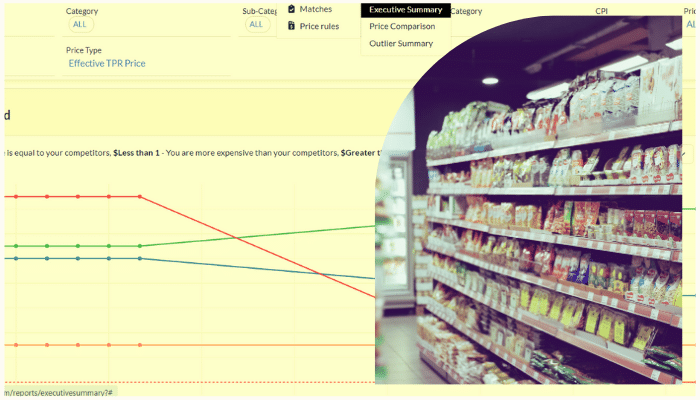Retail Pricing: A Strategic Guide to Rules-Based Price Optimization
Reading Time: 11 Minutes
Retail pricing defines your brand, builds trust, and sets shopper expectations. Whether you’re a grocery chain, convenience store, or general merchandise retailer, every price tag is a reflection of your strategy.
But behind every price sits a complex network of rules, constraints, and trade-offs.
Today’s most successful retailers aren’t just optimizing for margin; they’re delivering prices that align with strategic goals while obeying hard business rules, soft guidelines, and regulatory requirements (at scale).
Here’s why robust price rules management is foundational to retail success.
Retail Pricing: More Than Just a Number
Think about it: how would a shopper feel if a 2-pack of toothpaste was cheaper per ounce than a 3-pack? Or if the same energy drink was priced higher per ounce in a 12oz can than an 8oz one? Or if the “family pack” of chicken is more expensive per pound than smaller, individual packs.
These inconsistencies aren’t just confusing; they chip away at your price image and customer trust. Even worse, they’re often caused by pricing rule mismanagement, not intent. hey frequently stem from fragmented legacy systems, manual data entry leading to human error, or a lack of real-time synchronization between different pricing databases (e.g., POS, ERP, e-commerce). Complex promotional hierarchies, overlapping discounts, or misconfigured ‘buy X get Y’ rules can inadvertently create these illogical price relationships. Without a centralized pricing engine or clear governance over pricing rules, discrepancies inevitably creep into the system, creating bizarre pricing scenarios shoppers quickly notice.
In a study by Coresight Research, 96% of retailers admitted to pricing execution issues. 1 in 5 retailers reported that 15% of their assortment was priced incorrectly. That’s a problem.
Why Pricing Rules Exist & Why You Need to Get Them Right
Your business rules are a reflection of how you operate and compete. They include:
- Ending numbers (e.g., 0.99 pricing)
- Brand-to-private label price gaps
- Size and pack price parity
- Margin thresholds and markdown budgets
- Competitive price indices (CPI)
- State minimums and regulatory constraints
- Promotional limits and cadence
- Cross-zone consistency
- Attribute premiums (e.g., organic, energy-efficient)
- Lockdowns or price protections
And that’s just scratching the surface.
Pricing isn’t linear. It’s a web of dependencies, with relationships between products, channels, competitors, and formats. When one price changes due to cost, competitor move, or promotion, it can create ripple effects throughout your assortment. If your system isn’t built to track, manage, and enforce rules in real time, things break.
Hard Rules vs. Soft Rules
ClearDemand was the first to bring constrained optimization to retail pricing — and we patented the approach. Here’s how it works:
-
Hard Rules act like immovable boundaries, they can’t be violated. These might include regulatory minimums, price floor/ceilings, or must-have margins.
- Soft Rules are more flexible. They carry weight and intention but can be bent – for a cost. For example, you may want to stay 10% under a competitor but could relax that to 5% if margin is at risk.
Our pricing engine evaluates these rules, determines feasible price ranges and relationships, and then applies demand elasticity and rule penalties to find the optimal price.
It’s a strategic, scalable pricing system.
Example: When Pricing Rules Collide
Let’s say you’re pricing cold brew coffee:
- It costs you $2.50
- You have a 50% margin goal
- You also want to be 10% below your top competitor, who sells it at $4.75
Following the margin rule alone puts your price at $5.00. Following the competitive rule alone puts it at $4.28. Which one wins?
That’s where rule prioritization and rule softening come in. With ClearDemand’s technology, you can balance competing rules, quantify trade-offs, and make confident decisions.
Retail Pricing Maturity
Many retailers start with basic, manual pricing. Think ad hoc spreadsheets, limited rules, and minimal oversight. But the path to pricing excellence includes:
- Centralized rule management and approvals
- AI-driven price recommendations and elasticity modeling
- Constrained optimization with full rule compliance
- Lifecycle pricing that integrates with inventory, promos, and operations
- Dynamic adjustments and rule softening to test profitability vs. image
You can’t skip straight to the finish line. Like any discipline, retail pricing maturity is built step by step.
Convenience Stores: The Complexity of Every Day Pricing
C-stores have unique pricing challenges since they sell tobacco, beer, beverages, foodservice, snacks — each governed by different regulations, strategies, and pricing priorities. A single c-store may have hundreds of pricing rules in place.
Add to that the pressure from fast food outlets, supermarkets, and now delivery services like DoorDash and your pricing decisions are more critical than ever.
The right pricing system for c-stores should:
- Automate regulatory compliance
- Apply price rules based on zone, size, brand, and competitor
- Prioritize pricing logic to resolve conflicts
- Enable fast changes without manual intervention
- Deliver consistent, trustworthy price files to store-level systems
When done right, it saves labor, improves margin, and protects your store’s image with customers.
Rules-First Optimization
Optimization isn’t just algorithms. True price optimization starts with strong rules management. Without it, optimization is just guesswork. With it, optimization becomes a profit engine — constrained by logic, fueled by data, and aligned with your brand strategy.
If you’re serious about achieving price maturity, your foundation must include:
- A robust, flexible, and prioritized rules engine
- Automation of complex pricing dependencies
- Transparency into why every price is set
- Elasticity-powered optimization that respects your constraints
- Strategic rule softening and testing to explore new opportunities
A ClearDemand, we help retailers make pricing a growth driver. If you’re still managing rules in spreadsheets or applying them manually after the fact, you’re missing the full value of price optimization.
Let’s fix that.
Contact us to see a demo with pricing rule, elasticities, and optimization.
The Latest Insights – Straight to Your Inbox
Sign up for the ClearDemand mailing list for actionable strategies, upcoming events, industry trends, and company news.













